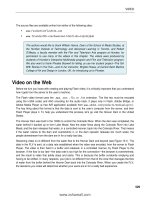Tài liệu The New Paradigm for Financial Markets docx
Bạn đang xem bản rút gọn của tài liệu. Xem và tải ngay bản đầy đủ của tài liệu tại đây (1.11 MB, 193 trang )
Soros.qxd
3/28/08
10:22 AM
Page i
The New Paradigm for
Financial Markets
Soros.qxd
3/28/08
10:22 AM
Page ii
also by george soros
The Age of Fallibility: The Consequences of the War on Terror
The Bubble of American Supremacy: The Cost of Bush’s War in Iraq
George Soros on Globalization
Open Society: Reforming Global Capitalism
The Crisis of Global Capitalism: Open Society Endangered
Soros on Soros: Staying Ahead of the Curve
Underwriting Democracy
Opening the Soviet System
The Alchemy of Finance: Reading the Mind of the Market
Soros.qxd
3/28/08
10:22 AM
Page iii
GEORGE SOROS
The New Paradigm for
Financial Markets
the credit crisis
of 2008 and
what it means
PublicAffairs
n e w yo r k
Soros.qxd
3/28/08
10:22 AM
Page iv
Copyright © 2008 by George Soros.
Published in the United States by PublicAffairs™,
a member of the Perseus Books Group.
All rights reserved.
Printed in the United States of America.
No part of this book may be reproduced in any manner whatsoever without written
permission except in the case of brief quotations embodied in critical articles and reviews. For information, address PublicAffairs, 250 West 57th Street, Suite 1321,
New York, NY 10107. PublicAffairs books are available at special discounts for
bulk purchases in the U.S. by corporations, institutions, and other organizations.
For more information, please contact the Special Markets Department at the
Perseus Books Group, 2300 Chestnut Street, Suite 200, Philadelphia, PA 19103,
call (800) 810-4145, x5000, or email
text set in janson text
Cataloging-in-Publication Data is available from the Library of Congress.
ISBN 978-1-58648-683-9 (hardback)
ISBN 978-1-58648-684-6 (e-book)
first edition
1 3 5 7 9 10 8 6 4 2
Soros.qxd
3/28/08
10:22 AM
Page v
Contents
Introduction
vii
Setting the Stage
xiii
Part One: Perspective
1. The Core Idea
3
2. Autobiography of a Failed Philosopher
12
3. The Theory of Reflexivity
25
4. Reflexivity in Financial Markets
51
Part Two:
The Current Crisis and Beyond
5. The Super-Bubble Hypothesis
81
6. Autobiography of a Successful Speculator
106
7. My Outlook for 2008
122
8. Some Policy Recommendations
142
Conclusion
153
Acknowledgments
About the Author
161
163
Soros.qxd
3/28/08
10:22 AM
Page vi
Soros.qxd
3/28/08
10:22 AM
Page vii
Introduction
We are in the midst of the worst financial crisis since the
1930s. In some ways it resembles other crises that have occurred in the last twenty-five years, but there is a profound
difference: the current crisis marks the end of an era of credit
expansion based on the dollar as the international reserve
currency. The periodic crises were part of a larger boombust process; the current crisis is the culmination of a superboom that has lasted for more than twenty-five years.
To understand what is going on we need a new paradigm.
The currently prevailing paradigm, namely that financial
markets tend towards equilibrium, is both false and misleading; our current troubles can be largely attributed to the fact
that the international financial system has been developed on
the basis of that paradigm.
The new paradigm I am proposing is not confined to the
financial markets. It deals with the relationship between
thinking and reality, and it claims that misconceptions and
misinterpretations play a major role in shaping the course of
history. I started developing this conceptual framework as a
student at the London School of Economics before I became
active in the financial markets. As I have written before, I was
greatly influenced by the philosophy of Karl Popper, and this
made me question the assumptions on which the theory of
Soros.qxd
viii
3/28/08
10:22 AM
Page viii
Introduction
perfect competition is based, in particular the assumption of
perfect knowledge. I came to realize that market participants
cannot base their decisions on knowledge alone, and their biased perceptions have ways of influencing not only market
prices but also the fundamentals that those prices are supposed to reflect. I argued that the participants’ thinking plays a
dual function. On the one hand, they seek to understand
their situation. I called this the cognitive function. On the
other hand, they try to change the situation. I called this the
participating or manipulative function. The two functions
work in opposite directions and, under certain circumstances, they can interfere with each other. I called this interference reflexivity.
When I became a market participant, I applied my conceptual framework to the financial markets. It allowed me to
gain a better understanding of initially self-reinforcing but
eventually self-defeating boom-bust processes, and I put that
insight to good use as the manager of a hedge fund. I expounded the theory of reflexivity in my first book, The
Alchemy of Finance, which was published in 1987. The book
acquired a cult following, but the theory of reflexivity was
not taken seriously in academic circles. I myself harbored
grave doubts about whether I was saying something new and
significant. After all, I was dealing with one of the most basic
and most thoroughly studied problems of philosophy, and
everything that could be said on the subject had probably already been said. Nevertheless, my conceptual framework remained something very important for me personally. It
guided me both in making money as a hedge fund manager
and in spending it as a philanthropist, and it became an integral part of my identity.
Soros.qxd
3/28/08
10:22 AM
Page ix
Introduction
When the financial crisis erupted, I had retired from actively managing my fund, having previously changed its status from an aggressive hedge fund to a more sedate
endowment fund. The crisis forced me, however, to refocus
my attention on the financial markets, and I became more actively engaged in making investment decisions. Then, towards the end of 2007, I decided to write a book analyzing
and explaining the current situation. I was motivated by
three considerations. First, a new paradigm was urgently
needed for a better understanding of what is going on. Second, engaging in a serious study could help me in my investment decisions. Third, by providing a timely insight into the
financial markets, I would ensure that the theory of reflexivity would finally receive serious consideration. It is difficult
to gain attention for an abstract theory, but people are intensely interested in the financial markets, especially when
they are in turmoil. I have already used the financial markets
as a laboratory for testing the theory of reflexivity in The
Alchemy of Finance; the current situation provides an excellent
opportunity to demonstrate its relevance and importance. Of
the three considerations, the third weighed most heavily in
my decision to publish this book.
The fact that I had more than one objective in writing it
makes the book more complicated than it would be if it were
focused solely on the unfolding financial crisis. Let me explain briefly how the theory of reflexivity applies to the crisis.
Contrary to classical economic theory, which assumes perfect knowledge, neither market participants nor the monetary and fiscal authorities can base their decisions purely on
knowledge. Their misjudgments and misconceptions affect
market prices, and, more importantly, market prices affect
ix
Soros.qxd
x
3/28/08
10:22 AM
Page x
Introduction
the so-called fundamentals that they are supposed to reflect.
Market prices do not deviate from a theoretical equilibrium
in a random manner, as the current paradigm holds. Participants’ and regulators’ views never correspond to the actual
state of affairs; that is to say, markets never reach the equilibrium postulated by economic theory. There is a two-way
reflexive connection between perception and reality which
can give rise to initially self-reinforcing but eventually selfdefeating boom-bust processes, or bubbles. Every bubble
consists of a trend and a misconception that interact in a reflexive manner. There has been a bubble in the U.S. housing
market, but the current crisis is not merely the bursting of
the housing bubble. It is bigger than the periodic financial
crises we have experienced in our lifetime. All those crises are
part of what I call a super-bubble—a long-term reflexive process which has evolved over the last twenty-five years or so. It
consists of a prevailing trend, credit expansion, and a prevailing
misconception, market fundamentalism (aka laissez-faire in
the nineteenth century), which holds that markets should be
given free rein. The previous crises served as successful tests
which reinforced the prevailing trend and the prevailing misconception. The current crisis constitutes the turning point
when both the trend and the misconception have become
unsustainable.
All this needs a lot more explanation. After setting the
stage, I devote the first part of this book to the theory of reflexivity, which goes well beyond the financial markets. People interested solely in the current crisis will find it hard
going, but those who make the effort will, I hope, find it rewarding. It constitutes my main interest, my life’s work.
Readers of my previous books will note that I have repeated
Soros.qxd
3/28/08
10:22 AM
Page xi
Introduction
some passages from them because the points I am making remain the same. Part 2 draws both on the conceptual framework and on my practical experience as a hedge fund
manager to illuminate the current situation.
xi
Soros.qxd
3/28/08
10:22 AM
Page xii
Soros.qxd
3/28/08
10:22 AM
Page xiii
Setting the Stage
The outbreak of the current financial crisis can be officially fixed as August 2007. That was when the central banks
had to intervene to provide liquidity to the banking system.
As the BBC reported:*
• On August 6, American Home Mortgage, one of the
largest U.S. independent home loan providers, filed for
bankruptcy after laying off the majority of its staff. The
company said it was a victim of the slump in the U.S.
housing market that had caught out many subprime borrowers and lenders.
• On August 9, short-term credit markets froze up after a
large French bank, BNP Paribas, suspended three of its
investment funds worth 2 billion euros, citing problems in
the U.S. subprime mortgage sector. BNP said it could not
value the assets in the funds because the market had disappeared. The European Central Bank pumped 95 billion
euros into the eurozone banking system to ease the subprime credit crunch. The U.S. Federal Reserve and the
Bank of Japan took similar steps.
*BBC News, “Timeline: Sub-Prime losses: How Did the Sub-Prime Crisis Unfold?” />
Soros.qxd
xiv
3/28/08
10:22 AM
Page xiv
Setting the Stage
• On August 10, the European Central Bank provided an
extra 61 billion euros of funds for banks. The U.S. Federal
Reserve said it would provide as much overnight money as
would be needed to combat the credit crunch.
• On August 13, the European Central Bank pumped 47.7
billion euros into the money markets, its third cash injection in as many working days. Central banks in the United
States and Japan also topped up earlier injections. Goldman Sachs said it would pump 3 billion dollars into a
hedge fund hit by the credit crunch to shore up its value.
• On August 16, Countrywide Financial, the largest U.S.
mortgage originator, drew down its entire 11.5 billion
dollar credit line. Australian mortgage lender Rams also
admitted liquidity problems.
• On August 17, the U.S. Federal Reserve cut the discount
rate (the interest rate at which it lends to banks) by a half a
percentage point to help banks deal with credit problems.
(But it did not help. Subsequently the central banks of the
developed world ended up injecting funds on a larger scale
for longer periods and accepting a wider range of securities as collateral than ever before in history.)
• On September 13, it was disclosed that Northern Rock
(the largest British mortgage banker) was bordering on insolvency (which triggered an old-fashioned bank run—for
the first time in Britain in a hundred years).
The crisis was slow in coming, but it could have been anticipated several years in advance. It had its origins in the
bursting of the Internet bubble in late 2000. The Fed responded by cutting the federal funds rate from 6.5 percent to
Soros.qxd
3/28/08
10:22 AM
Page xv
Setting the Stage
3.5 percent within the space of just a few months. Then came
the terrorist attack of September 11, 2001. To counteract the
disruption of the economy, the Fed continued to lower
rates—all the way down to 1 percent by July 2003, the lowest
rate in half a century, where it stayed for a full year. For
thirty-one consecutive months the base inflation-adjusted
short-term interest rate was negative.
Cheap money engendered a housing bubble, an explosion
of leveraged buyouts, and other excesses. When money is
free, the rational lender will keep on lending until there is no
one else to lend to. Mortgage lenders relaxed their standards
and invented new ways to stimulate business and generate
fees. Investment banks on Wall Street developed a variety of
new techniques to hive credit risk off to other investors, like
pension funds and mutual funds, which were hungry for
yield. They also created structured investment vehicles
(SIVs) to keep their own positions off their balance sheets.
From 2000 until mid-2005, the market value of existing
homes grew by more than 50 percent, and there was a frenzy of
new construction. Merrill Lynch estimated that about half
of all American GDP growth in the first half of 2005 was
housing related, either directly, through home building and
housing-related purchases like new furniture, or indirectly,
by spending the cash generated from the refinancing of
mortgages. Martin Feldstein, a former chairman of the
Council of Economic Advisers, estimated that from 1997
through 2006, consumers drew more than $9 trillion in cash
out of their home equity. A 2005 study led by Alan Greenspan estimated that in the 2000s, home equity withdrawals
were financing 3 percent of all personal consumption. By the
xv
Soros.qxd
xvi
3/28/08
10:22 AM
Page xvi
Setting the Stage
first quarter of 2006, home equity extraction made up nearly
10 percent of disposable personal income.*
Double-digit price increases in house prices engendered
speculation. When the value of property is expected to rise
more than the cost of borrowing, it makes sense to own more
property than one wants to occupy. By 2005, 40 percent of all
homes purchased were not meant to serve as permanent residences but as investments or second homes.† Since growth in
real median income was anemic in the 2000s, lenders
strained ingenuity to make houses appear affordable. The
most popular devices were adjustable rate mortgages
(ARMs) with “teaser,” below-market initial rates for an initial two-year period. It was assumed that after two years,
when the higher rate kicked in, the mortgage would be refinanced, taking advantage of the higher prices and generating a
new set of fees for the lenders. Credit standards collapsed,
and mortgages were made widely available to people with
low credit ratings (called subprime mortgages), many of
whom were well-to-do. “Alt-A” (or liar loans), with low or
no documentation, were common, including, at the extreme,
“ninja” loans (no job, no income, no assets), frequently with
the active connivance of the mortgage brokers and mortgage
lenders.
*Economist, September 10, 2005; Martin Feldstein, “Housing, Credit Markets
and the Business Cycle,” National Bureau of Economic Research working paper
13,471, October 2007; Alan Greenspan and James Kennedy, “Estimates of
Home Mortgage Origination, Repayments, and Debts on One- to Four-Family
Residences,” Federal Reserve staff working paper 2005–41 (data updated
through 2007 by Dr. Kennedy and furnished to the author).
†Joseph R. Mason and Joshua Rosner, “How Resilient Are Mortgage Backed Securities to Collateralized Debt Obligation Market Disruption?” paper presented at the Hudson Institute, Washington, D.C., February 15, 2007, 11.
Soros.qxd
3/28/08
10:22 AM
Page xvii
Setting the Stage
Banks sold off their riskiest mortgages by repackaging
them into securities called collateralized debt obligations
(CDOs). CDOs channeled the cash flows from thousands of
mortgages into a series of tiered, or tranched, bonds with
risks and yields tuned to different investor tastes. The toptier tranches, which comprised perhaps 80 percent of the
bonds, would have first call on all underlying cash flows, so
they could be sold with a AAA rating. The lower tiers absorbed first-dollar risks but carried higher yields. In practice,
the bankers and the rating agencies grossly underestimated
the risks inherent in absurdities like ninja loans.
Securitization was meant to reduce risks through risk tiering and geographic diversification. As it turned out, they increased the risks by transferring ownership of mortgages
from bankers who knew their customers to investors who did
not. Instead of a bank or savings and loan approving a credit
and retaining it on its books, loans were sourced by brokers;
temporarily “‘warehoused” by thinly capitalized “mortgage
bankers”; then sold en bloc to investment banks, who manufactured the CDOs, which were rated by ratings agencies
and sold off to institutional investors. All income from the
original sourcing through the final placement was fee
based—the higher the volumes, the bigger the bonuses. The
prospect of earning fees without incurring risks encouraged
lax and deceptive business practices. The subprime area,
which dealt with inexperienced and uninformed customers,
was rife with fraudulent activities. The word “teaser rates”
gave the game away.
Starting around 2005, securitization became a mania. It
was easy and fast to create “synthetic” securities that mimicked the risks of real securities but did not carry the expense of
xvii
Soros.qxd
xviii
3/28/08
10:22 AM
Page xviii
Setting the Stage
buying and assembling actual loans. Risky paper could therefore be multiplied well beyond the actual supply in the market. Enterprising investment bankers sliced up CDOs and
repackaged them into CDOs of CDOs, or CDO2s. There
were even CDO3s. The highest slices of lower-rated CDOs
obtained AAA ratings. In this way more AAA liabilities were
created than there were AAA assets. Towards the end, synthetic products accounted for more than half the trading
volume.
The securitization mania was not confined to mortgages
and spread to other forms of credit. By far the largest synthetic market is constituted by credit default swaps (CDSs).
This arcane synthetic financial instrument was invented in
Europe in the early 1990s. Early CDSs were customized
agreements between two banks. Bank A, the swap seller (protection purchaser), agreed to pay an annual fee for a set period
of years to Bank B, the swap buyer (protection seller), with respect to a specific portfolio of loans. Bank B would commit to
making good Bank A’s losses on portfolio defaults during the
life of the swap. Prior to CDSs, a bank wishing to diversify its
portfolio would need to buy or sell pieces of loans, which was
complicated because it required the permission of the borrower; consequently, this form of diversification became very
popular. Terms were standardized, and the notional value of
the contracts grew to about a trillion dollars by 2000.
Hedge funds entered the market in force in the early
2000s. Specialized credit hedge funds effectively acted as unlicensed insurance companies, collecting premiums on the
CDOs and other securities that they insured. The value of
the insurance was often questionable because contracts could
be assigned without notifying the counterparties. The mar-
Soros.qxd
3/28/08
10:22 AM
Page xix
Setting the Stage
ket grew exponentially until it came to overshadow all other
markets in nominal terms. The estimated nominal value of
CDS contracts outstanding is $42.6 trillion. To put matters
in perspective, this is equal to almost the entire household
wealth of the United States. The capitalization of the U.S.
stock market is $18.5 trillion, and the U.S. treasuries market
is only $4.5 trillion.
The securitization mania led to an enormous increase in
the use of leverage. To hold ordinary bonds requires a margin of 10 percent; synthetic bonds created by credit default
swaps can be traded on a margin of 1.5 percent. This allowed
hedge funds to show good profits by exploiting risk differentials on a leveraged basis, driving down risk premiums.
It was bound to end badly. There was a precedent to go by.
The market in collateralized mortgage obligations (CMOs)
started to develop in the 1980s. In 1994, the market in the
lowest-rated tranches—or “toxic waste,” as they were
known—blew up when a $2 billion hedge fund could not
meet a margin call, leading to the demise of Kidder Peabody
and total losses of about $55 billion. But no regulatory action
was taken. Former Federal Reserve governor Edward M.
Gramlich privately warned Federal Reserve Chairman Alan
Greenspan about abusive behavior in the subprime mortgage
markets in 2000, but the warning was swept aside. Gramlich
went public with his worries in 2007 and published a book on
the subprime bubble just before the crisis first broke. Charles
Kindleberger, an expert on bubbles, warned of the housing
bubble in 2002. Martin Feldstein, Paul Volcker (former
chairman of the Federal Reserve), and Bill Rhodes (a senior
official of Citibank) all made bearish warnings. Nouriel
Roubini predicted that the housing bubble would lead to a
xix
Soros.qxd
xx
3/28/08
10:22 AM
Page xx
Setting the Stage
recession in 2006. But no one, including myself, anticipated
how big the bubble could grow and how long it could last. As
the Wall Street Journal recently noted, there were many
hedge funds taking a bearish stance on housing, but “they
suffered such painful losses waiting for a collapse” that most
eventually gave up their positions.*
Signs of trouble started to multiply early in 2007. On February 22, HSBC fired the head of its U.S. mortgage lending
business, recognizing losses reaching $10.8 billion. On
March 9, DR Horton, the biggest U.S. homebuilder, warned
of losses from subprime mortgages. On March 12, New
Century Financial, one of the biggest subprime lenders, had
its shares suspended from trading amid fears that the company was headed for bankruptcy. On March 13, it was
reported that late payments on mortgages and home foreclosures rose to new highs. On March 16, Accredited Home
Lenders Holding put up $2.7 billion of its subprime loan
book for sale at a heavy discount to generate cash for business operations. On April 2, New Century Financial filed for
Chapter 11 bankruptcy protection after it was forced to repurchase billions of dollars worth of bad loans.†
On June 15, 2007, Bear Stearns announced that two large
mortgage hedge funds were having trouble meeting margin
calls. Bear grudgingly created a $3.2 billion credit line to bail
out one fund and let the other collapse. Investors’ equity of
$1.5 billion was mostly wiped out.
*Wall Street Journal, February 27, 2008, and January 15, 2008; New York Times,
October 26, 2007.
†“Bleak Housing Outlook for US Firm,” BBC News, March 8, 2007, http://
news.bbc.co.uk/2/hi/business/6429815.stm.
Soros.qxd
3/28/08
10:22 AM
Page xxi
Setting the Stage
The failure of the two Bear Stearns mortgage hedge funds
in June badly rattled the markets, but U.S. Federal Reserve
Chairman Ben Bernanke and other senior officials reassured
the public that the subprime problem was an isolated phenomenon. Prices stabilized, although the flow of bad news
continued unabated. As late as July 20, Bernanke still estimated subprime losses at only about $100 billion. When
Merrill Lynch and Citigroup took big write-downs on inhouse collateralized debt obligations, the markets actually
staged a relief rally. The S&P 500 hit a new high in mid-July.
It was only at the beginning of August that financial markets really took fright. It came as a shock when Bear Stearns
filed for bankruptcy protection for two hedge funds exposed
to subprime loans and stopped clients from withdrawing
cash from a third fund. As mentioned, Bear Stearns had tried to
save these entities by providing $3.2 billion of additional
funding.
Once the crisis erupted, financial markets unraveled with
remarkable rapidity. Everything that could go wrong did. A
surprisingly large number of weaknesses were revealed in a
remarkably short period of time. What started with lowgrade subprime mortgages soon spread to CDOs, particularly
those synthetic ones that were constructed out of the top slice of
subprime mortgages. The CDOs themselves were not readily
tradable, but there were tradable indexes representing the
various branches. Investors looking for cover and short sellers
looking for profits rushed to sell these indexes, and they declined precipitously, bringing the value of the various
branches of CDOs that they were supposed to represent into
question. Investment banks carried large positions of CDOs
off balance sheet in so-called structured investment vehicles
xxi
Soros.qxd
xxii
3/28/08
10:22 AM
Page xxii
Setting the Stage
(SIVs). The SIVs financed their positions by issuing assetbacked commercial paper. As the value of CDOs came into
question, the asset-backed commercial paper market dried
up, and the investment banks were forced to bail out their
SIVs. Most investment banks took the SIVs into their balance
sheets and were forced to recognize large losses in the process. Investment banks were also sitting on large loan commitments to finance leveraged buyouts. In the normal course
of events, they would package these loans as collateralized
loan obligations (CLOs) and sell them off, but the CLO market
came to a standstill together with the CDO market, and the
banks were left holding a bag worth about $250 billion. Some
banks allowed their SIVs to go bust, and some reneged on
their leveraged buyout obligations. This, together with the
size of the losses incurred by the banks, served to unnerve the
stock market, and price movements became chaotic. Socalled market-neutral hedge funds, which exploit small discrepancies in market prices by using very high leverage,
ceased to be market neutral and incurred unusual losses. A
few highly leveraged ones were wiped out, damaging the reputation of their sponsors and unleashing lawsuits.
All this put tremendous pressure on the banking system.
Banks had to put additional items on their balance sheets at a
time when their capital base was impaired by unexpected
losses. They had difficulty assessing their exposure and even
greater difficulties estimating the exposure of their counterparts. Consequently they were reluctant to lend to each
other and eager to hoard their liquidity. At first, central
banks found it difficult to inject enough liquidity because
commercial banks avoided using any of the facilities which
had an onus attached to them, and they were also reluctant to
Soros.qxd
3/28/08
10:22 AM
Page xxiii
Setting the Stage
deal with each other, but eventually these obstacles were
overcome. After all, if there is one thing central banks know
how to do, that is to provide liquidity. Only the Bank of England suffered a major debacle when it attempted to rescue
Northern Rock, an overextended mortgage lender. Its rescue
effort resulted in a run on the bank. Eventually Northern
Rock was nationalized and its obligations added to the national debt, pushing the United Kingdom beyond the limits
imposed by the Maastricht Treaty.
Although liquidity had been provided, the crisis refused to
abate. Credit spreads continued to widen. Almost all the major
banks—Citigroup, Merrill Lynch, Lehman Brothers, Bank
of America, Wachovia, UBS, Credit Suisse—announced major
write-downs in the fourth quarter, and most have signaled
continued write-downs in 2008. Both AIG and Credit Suisse
made preliminary fourth-quarter write-down announcements that they repeatedly revised, conveying the doubtless
accurate impression that they had lost control of their balance sheets. A $7.2 billion trading fiasco at Société Générale
announced on January 25, 2008, coincided with a selling climax in the stock market and an extraordinary 75 basis point
cut in the federal funds rate eight days before the regularly
scheduled meeting, when the rate was cut a further 50 basis
points. This was unprecedented.
Distress spread from residential real estate to credit card
debt, auto debt, and commercial real estate. Trouble at the
monoline insurance companies, which traditionally specialized in municipal bonds but ventured into insuring structured and synthetic products, caused the municipal bond
market to be disrupted. An even larger unresolved problem is
looming in the credit default swaps market.
xxiii
Soros.qxd
xxiv
3/28/08
10:22 AM
Page xxiv
Setting the Stage
Over the past several decades the United States has weathered several major financial crises, like the international lending
crisis of the 1980s and the savings and loan crisis of the early
1990s. But the current crisis is of an entirely different character.
It has spread from one segment of the market to others, particularly those which employ newly created structured and
synthetic instruments. Both the exposure and the capital base
of the major financial institutions have been brought into
question, and the uncertainties are likely to remain unresolved for an extended period of time. This is impeding the
normal functioning of the financial system and is liable to
have far-reaching consequences for the real economy.
Both the financial markets and the financial authorities
have been very slow to recognize that the real economy is
bound to be affected. It is hard to understand why this should
be so. The real economy was stimulated by credit expansion.
Why should it not be negatively affected by credit contraction? One cannot escape the conclusion that both the financial authorities and market participants harbor fundamental
misconceptions about the way financial markets function.
These misconceptions have manifested themselves not only
in a failure to understand what is going on; they have given
rise to the excesses which are at the root of the current market turmoil.
In Part 1, I shall lay out the conceptual framework in
terms of which the functioning of financial markets can be
understood. In Part 2, I shall apply that framework to the
present moment in history.









